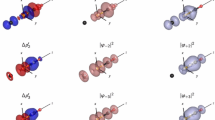Abstract
In this paper, we outline the foundations of the time invariant, non-unitary covering of quantum chemistry known as hadronic chemistry, we illustrate its validity by reviewing the exact representations of the binding energies of the Hydrogen and water molecules, and present new advances.



Similar content being viewed by others
Notes
For example let us consider a divergent canonical series,
$$\begin{aligned} A(k)=A(0)+k \times [A,H]/1!+k^2 \times [[A,H],H]/2!+ \cdots \longrightarrow \infty , k>1, \end{aligned}$$where \([A,H] = A \times H - H \times A\) is the familiar Lie product, and the operators \(A\) and \(H\) are Hermitian and sufficiently bounded. Then under the isotopic lifting the preceding series becomes
$$\begin{aligned} {\hat{A}}(k)&={\hat{A}}(0)+k \times [A{\hat{,}H}]/1!+k^2 \times [[A{\hat{,}H}]{\hat{,}H}]/2!+ \cdots \le |N| < \infty ,\\ [A {\hat{,}H}]&= A \times {\widehat{T}} \times H - H \times \widehat{T} \times A, \end{aligned}$$which holds e.g. for the case \(\widehat{T} = \epsilon \times k^{-1}\) where \(\epsilon\) is sufficiently small positive definite constant. This shows that the original divergent coefficient are now turned into the convergent coefficients. Therefore, by permitting fast convergence of perturbative series, all known applications of hadronic mechanics allows much faster computations. For example, when computer uses iteration method of computation obviously due to the fast convergence of the series having isotopic element as variable it would take drastically less steps of iterations.
As described in the following paragraph it is assumed that each isoelectronium sees only one positive charge located at the nucleus of Oxygen atom.
References
Animalu, A.O.E.: Isosuperconductivity: a nonlocal-nonHamiltonian theory of pairing in high-Tc superconducitivity. Hadronic J. 17, 349–427 (1994)
Ankerberg, J., Weldon, J.: Encyclopedia of New Age Beliefs, p. 520. Harvest House, Wilmington (1996)
Aringazin, A.K., Kucherenko, M.G.: Exact solution of the restricted three-body Santilli–Shillady model of \(\text{ H}_2\) molecule. Hadronic J. 23, 1 (2000)
Aringazin, A.K.: On variational solution of the four-body Santilli–Shillady model of \(\text{ H}_2\) molecule. Hadronic J. 23, 57 (2000)
Bhalekar, A.A.: Santilli’s new mathematics for chemists and biologists. An introductory account. Hadronic J. (2013). http://www.santilli-foundation.org/docs/RhodesGreece_AAB
Corda, C.: Numerical analysis and applied mathematics ICNAAM 2012 AIP. Conf. Proc. 1479, 1013–1016 (2012). doi:10.1063/1.4756316
Eyring, H., Walter, J., Kimball, G.E.: Quantum Chemistry. Wiley, New York (1961)
Frost, A.A., Pearson, R.G.: Kinetics and Mechanism. Wiley, New York (1961)
Gandzha, I., Kadisvily, J.: New Science for A New Era. Sankata Printing Press, Kathmandu, Nepal (2011). http://www.santilli-foundation.org/docs/RMS
Heisenberg, W.: Physics and Beyond. Harper and Row, New York (1971)
Jiang, Chun-Xuan.: Foundations of Santilli’s Isonumber Theory, with Applications to New Cryptograms, Fermats Theorem and Goldbachs Conjecture. International Academic Press, America-Europe-Asia (2002). http://www.i-b-r.org/docs/jiang
Kauzmann, W.: Quantum Chemistry: An introduction. Academic Press, New York (1957)
Pérez-Enríquez, R., Marín, J.L., Riera, R.: Exact solution of the three-body Santilli–Shillady model of the Hydrogen molecule. Prog. Phys. 2, 34–41 (2007)
Santilli, R.M.: Need of subjecting to an experimental verification the validity within a hadron of Einstein special relativity and Pauli exclusion principle. Hadronic J. 1, 574–901 (1978). http://www.santilli-foundation.org/docs/santilli-73
Santilli, R.M., Shillady, D.D.: A new isochemical model of the Hydrogen molecule. Int. J. Hydrogen Energy 24, 943–956 (1999). http://www.santilli-foundation.org/docs/Santilli-135
Santilli, R.M., Shillady, D.D.: A new isochemical model of the water molecule. Int. J. Hydrogen Energy 25, 173–183 (2000). http://www.santilli-foundation.org/docs/Santilli-39
Santilli, R.M.: Foundations of Hadronic Chemistry. Kluwer Academic Publisher, Dordrecht (2001). http://www.santilli-foundation.org/docs/santilli-113
Santilli, R.M.: Hadronic Mathematics, Mechanics and Chemistry: Limitations of Einsteins Special and General Relativities, Quantum Mechanics and Quantum Chemistry, vol. I. International Academic Press, New York (2007)
Santilli, R.M.: Hadronic Mathematics, Mechanics and Chemistry: Iso-, Geno-, Hyper-Formulations for Matter and Their Isoduals for Antimatter, vol. III. International Academic Press, New York (2007)
Santilli, R.M.: Hadronic Mathematics, Mechanics and Chemistry: Experimental Verifications, Theoretical Advances and Industrial Applications in Chemistry, vol. V. International Academic Press, New York (2008)
Trell, E.: Foundations of hadronic chemistry with applications to new clean energies and fuels. Int. J. Hydrogen Energy 28, 251–253 (2003)
Acknowledgments
The financial support from The Santilli Foundation is gratefully acknowledged. I am indebted especially to Professor R. M. Santilli for his guidance and motivation during the seminar course on Hadronic Mechanics and inviting me to write this paper with valuable guidance. The author is also thankful to Mrs. Carla Santilli, Professor C. Corda and Professor R. Anderson for all the encouragement and for providing an opportunity to learn Santilli’s new mathematics and its applications. Finally the author is personally thankful to Professor A. A. Bhalekar for initiating me in this subject and providing valuable guidance and encouragement at every stage of the writing of this review paper. This work is financially supported by The Santilli Foundation and presented at the Seminar Course on Hadronic Mechanics, in International Conference of Numerical Analysis and Applied Mathematics (ICNAAM)—2012, at Kos, Greece, during 19–25 September 2012.
Author information
Authors and Affiliations
Corresponding author
Rights and permissions
About this article
Cite this article
Tangde, V.M. Advances in hadronic chemistry and its applications. Found Chem 17, 163–179 (2015). https://doi.org/10.1007/s10698-015-9218-z
Published:
Issue Date:
DOI: https://doi.org/10.1007/s10698-015-9218-z




